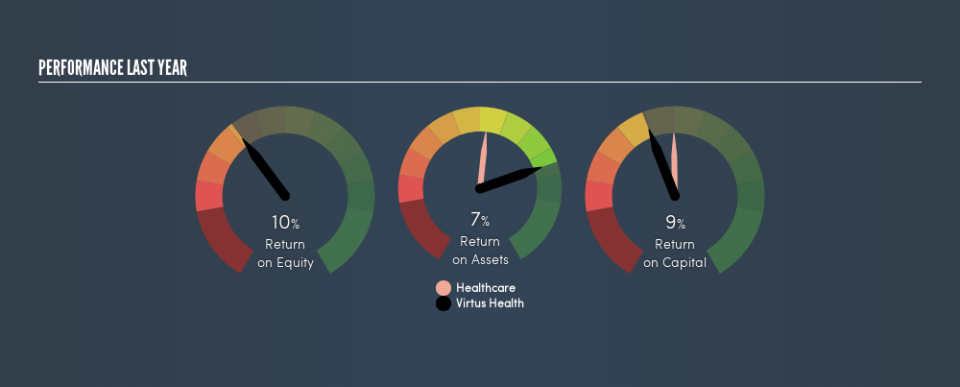Are Virtus Health Limited’s Returns On Capital Worth Investigating?

Want to participate in a short research study? Help shape the future of investing tools and you could win a $250 gift card!
Today we'll evaluate Virtus Health Limited (ASX:VRT) to determine whether it could have potential as an investment idea. Specifically, we're going to calculate its Return On Capital Employed (ROCE), in the hopes of getting some insight into the business.
First up, we'll look at what ROCE is and how we calculate it. Second, we'll look at its ROCE compared to similar companies. Last but not least, we'll look at what impact its current liabilities have on its ROCE.
What is Return On Capital Employed (ROCE)?
ROCE is a metric for evaluating how much pre-tax income (in percentage terms) a company earns on the capital invested in its business. In general, businesses with a higher ROCE are usually better quality. Ultimately, it is a useful but imperfect metric. Renowned investment researcher Michael Mauboussin has suggested that a high ROCE can indicate that 'one dollar invested in the company generates value of more than one dollar'.
So, How Do We Calculate ROCE?
The formula for calculating the return on capital employed is:
Return on Capital Employed = Earnings Before Interest and Tax (EBIT) ÷ (Total Assets - Current Liabilities)
Or for Virtus Health:
0.094 = AU$47m ÷ (AU$551m - AU$54m) (Based on the trailing twelve months to December 2018.)
So, Virtus Health has an ROCE of 9.4%.
View our latest analysis for Virtus Health
Does Virtus Health Have A Good ROCE?
One way to assess ROCE is to compare similar companies. Using our data, Virtus Health's ROCE appears to be around the 9.3% average of the Healthcare industry. Aside from the industry comparison, Virtus Health's ROCE is mediocre in absolute terms, considering the risk of investing in stocks versus the safety of a bank account. Readers may find more attractive investment prospects elsewhere.
When considering ROCE, bear in mind that it reflects the past and does not necessarily predict the future. Companies in cyclical industries can be difficult to understand using ROCE, as returns typically look high during boom times, and low during busts. This is because ROCE only looks at one year, instead of considering returns across a whole cycle. What happens in the future is pretty important for investors, so we have prepared a free report on analyst forecasts for Virtus Health.
How Virtus Health's Current Liabilities Impact Its ROCE
Liabilities, such as supplier bills and bank overdrafts, are referred to as current liabilities if they need to be paid within 12 months. The ROCE equation subtracts current liabilities from capital employed, so a company with a lot of current liabilities appears to have less capital employed, and a higher ROCE than otherwise. To counteract this, we check if a company has high current liabilities, relative to its total assets.
Virtus Health has total liabilities of AU$54m and total assets of AU$551m. As a result, its current liabilities are equal to approximately 9.9% of its total assets. Virtus Health has a low level of current liabilities, which have a minimal impact on its uninspiring ROCE.
Our Take On Virtus Health's ROCE
Virtus Health looks like an ok business, but on this analysis it is not at the top of our buy list. Of course, you might also be able to find a better stock than Virtus Health. So you may wish to see this free collection of other companies that have grown earnings strongly.
I will like Virtus Health better if I see some big insider buys. While we wait, check out this free list of growing companies with considerable, recent, insider buying.
We aim to bring you long-term focused research analysis driven by fundamental data. Note that our analysis may not factor in the latest price-sensitive company announcements or qualitative material.
If you spot an error that warrants correction, please contact the editor at editorial-team@simplywallst.com. This article by Simply Wall St is general in nature. It does not constitute a recommendation to buy or sell any stock, and does not take account of your objectives, or your financial situation. Simply Wall St has no position in the stocks mentioned. Thank you for reading.


